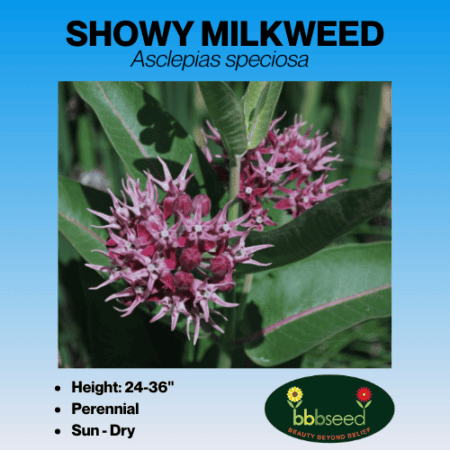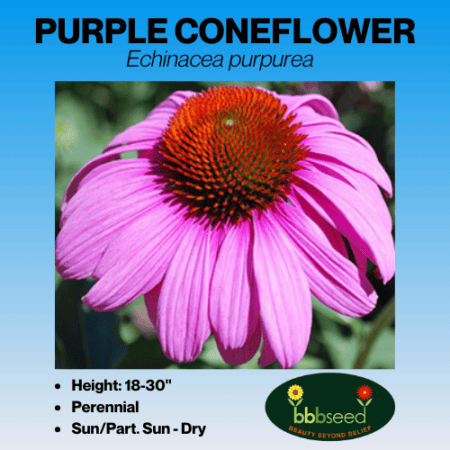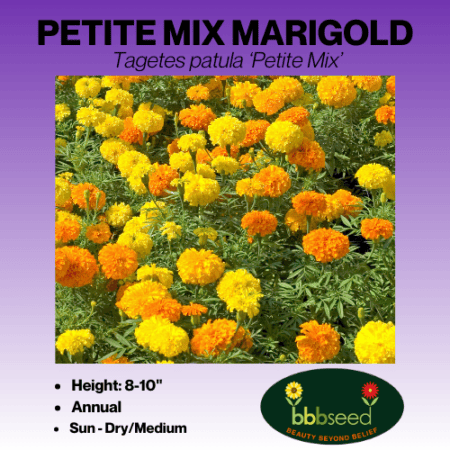Description
Showy Milkweed, Asclepias speciosa
This hardy perennial, whose scientific name comes from the Greek god of medicine, is a favorite of butterflies. This species has traditionally provided food, medicines, and fiber. The clusters of star-shaped flowers will range from dark rose to white for tall woody stems with milky sap and alternate, oval leaves that are velvety underneath. These plants grow well in a variety of locations from prairies and open woodlands to roadsides. The seeds are easy to grow and do well when planted in the fall or when cold-treated for up to three months before planting. Showy Milkweed will spread through seed distribution and underground shoots. Monarch Butterflies lay their eggs on the milkweed and the larvae feed on the plants. Note that these plants contain cardiac glycosides, chemicals, that are toxic when eaten and make the Monarch Butterflies also toxic to any would-be predators. These seeds have a high percentage of dormant seeds, so to achieve better germination, cold treat the seeds by planting in the late fall or put seeds in a plastic bag in the refrigerator with a damp paper towel for several weeks before planting in the spring.
Color: Rose/Pink
Height: 24-36″
Type: Perennial
Climate: Sun-Dry
Seeds/lb.: 72,000
Rate: 1oz./60 sq.ft.
Bloom time: May-July
Packet weight: 1 gm (approx. 75 seeds)
Zones: 3b-8b
Some tips for planting and growing Milkweed successfully
Milkweed seed has a high percentage of dormancy, which means that many of the seeds in your packet won’t germinate without special treatment or will germinate, not this season, but maybe the next season. So here are some suggestions.
-Prep:
Milkweed seeds need to be exposed to cold temperatures that normally occur in winter to help to break the natural dormancy and help to soften the hard outer casing. If you are planning to start your Milkweeds indoors, you will need to do this cold stratification, yourself. You can do this by putting your Milkweed seed in a damp paper towel, folding it to fit into a sealed plastic bag, then placing the bag into the refrigerator. Keep it there for 4-6 weeks.
Other methods: Nick seeds with a sharp razor blade. Soak seeds in hot (190 deg. F, to start) water for 12 hours prior to planting. (not as successful)
– Planting:
Plant in small 2-4″ peat pots (recommended) or tall plastic pots. Use ‘seed-starting’ soil or medium. Moisten the soil, place 1-2 seeds into each pot and cover with no more than 1/6″ damp soil or medium. Place the pots where they can drain. Water gently or fill a tray with 1/2 ” water to be absorbed from the bottom of the peat pots. Dump the excess water after absorption. Water when the top of the soil is dry and don’t overwater. Milkweed seeds germinate in warm conditions, so place tray of pots in a warm sunny window, greenhouse, or under a grow light. Germination in 10-15 days for cold-stratified seeds. To encourage sturdy stems, place your grow light bulb close to the soil. Sometimes a small fan blowing gently towards the new seedlings will encourage sturdier stems.
– Other planting methods:
Plant non-stratified seed into peat pots filled with seed-starting soil or medium. Moisten, and place in a greenhouse or under grow light. This germination might take several months. If planting outside, seed in late fall. Let the Milkweed seed remain over the winter. This will accomplish the cold-stratification, needed. Germination should occur when the soil warms and the days are longer.
-Transplanting:
When plants reach 2-3″ tall, transplant outdoors in full sun in early spring after danger of frost is past. Milkweed produces a long taproot, so take care to not disturb the roots. Plant peat pots so that the top edge of the small pot is underground to avoid drying out. If your Milkweed seedlings were planted in plastic pots, take extra care to not disturb the roots. Water after planting until plants are established. Then tapering off, unless the season is extremely dry. The newly planted Milkweed seedlings may lose all their leaves due to transplant shock but should grow them back again.









Reviews
There are no reviews yet.